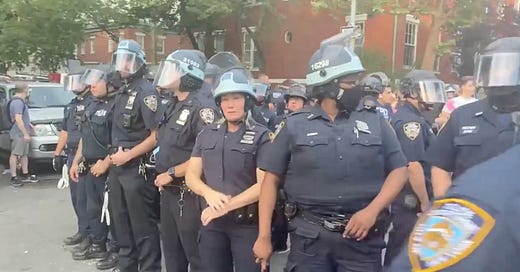Hope the New York Times Is Happy Now
The NYPD attacked queer people again. Maybe the paper should revisit its editorial begging for cops to be allowed at Pride.
On Sunday, Pride took place in New York City, and the police attacked queer people.


The attacks took place in Washington Square Park—the exact place that cops attacked queer people celebrating Pride last year, and the site of a recent escalation in police repression over the past few weeks.
Looking at the above footage will make you think a lot of different things. I found myself thinking, "I wonder if the New York Times is happy now."
The Times, you may recall, wrote a remarkably ill-conceived editorial in May decrying the decision to ban cops from marching in the official New York City Pride parade. (That event was mostly virtual this year; much-better alternatives like the Queer Liberation March, which bans cops and corporations, did take place.) The editorial was thoroughly taken apart after it landed, but, in the wake of yet another display of police violence, it's worth remembering just how dismissive the Times was about the idea that it is wrong to celebrate the police at Pride.
The editorial was especially bizarre because it contained a lengthy acknowledgment of the history of police violence against queer people, from the very obvious mention of Stonewall to the attacks on the Queer Liberation March just last year. But it was clear that the Times didn't think these things mattered much. It described the police violence at the Queer Liberation March as—you guessed it—a "confrontation" between police and protesters. It also described the widespread NYPD violence against Black Lives Matter protesters in 2020 as "perceived misconduct" — an astonishing thing to say, especially since one of the places that documented that violence intensely was the New York Times. Then it summed its view up this way:
But barring L.G.B.T.Q. officers from marching is a politicized response and is hardly worthy of the important pursuit of justice for those persecuted by the police. The organizers are certainly within their rights to reduce the number of armed police officers providing security, but let’s be honest: It’s a poke in the eye at law enforcement more than a meaningful action to address police violence or foster a dialogue about law enforcement reform. These moves do nothing to celebrate and demonstrate solidarity within the L.G.B.T.Q. community.
For the Times, welcoming a police force that has shown, for decades, that it is happy to mete out violence against queer people and anyone else it fancies, is not a political act—but banning them is a political act, and a snotty, immature one at that. Even after the convulsions of 2020, the leading newspaper in America still considers cops to be the pillars of the community and thinks anyone who opposes that notion is giving in to hysteria and prejudice.
But look at those videos again. They do not show two allied forces. Maybe some of those cops are gay! It doesn't matter in the end, because being a cop has taken priority. The cops in those videos are not standing with queer people. They are squarely standing against them.
People don't want to ban cops from Pride out of hysteria. They want to ban cops from Pride because cops continually show that their support of queer people is conditioned on queer people not questioning the right of the police to dominate and terrorize society as they see fit. They want to ban cops from Pride because they want to send a message that wielding state power in this country is antithetical to supporting any kind of liberation.
One would hope that this weekend's events would have made the Times editorial board reconsider its instinctive contempt towards these ideas, but let's be real: they haven't learned anything.







